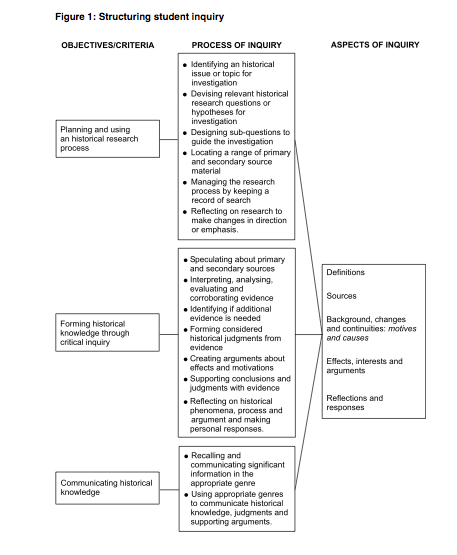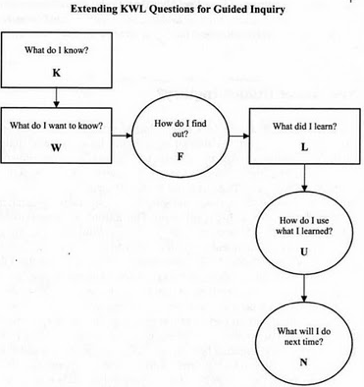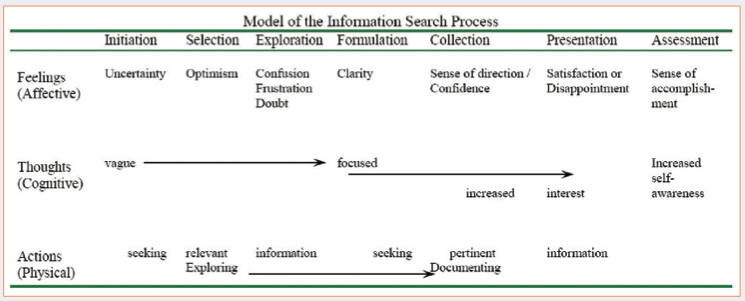QSA Senior Modern History Syllabus
As a result of the research assignment beeing based around the QSA Senior Modern History Syllabus there were strong links to inquiry-based learning. The general research objectives of Modern History as outlined by QSA (2004, p. 7) include:
Students are also required to develop historical knowledge through critical inquiry and the unit plans designed within the QSA Modern History Syllabus are grounded in inquiry-based learning. In each unit, teachers are required to structure student inquiry before and throughout the assessment period.
As a result of the research assignment beeing based around the QSA Senior Modern History Syllabus there were strong links to inquiry-based learning. The general research objectives of Modern History as outlined by QSA (2004, p. 7) include:
- identifying issues or problems for investigation
- developing focus research questions, hypotheses and sub-questions
- devising formats for research that suit the purpose of the research task
- locating and use a variety of primary and secondary sources
- maintaining a coherent record of research
- displaying initiative and independence in the planning and management of all stages of the research process
- demonstrating evaluation of the research process and findings, and ongoing revision of the research process as a consequence.
Students are also required to develop historical knowledge through critical inquiry and the unit plans designed within the QSA Modern History Syllabus are grounded in inquiry-based learning. In each unit, teachers are required to structure student inquiry before and throughout the assessment period.
Kuhlthau’s Guided Inquiry model
Whilst no set information learning theory was applied to this research project, several links can be found between the ILA and Kuhlthau’s Guided Inquiry Model. The structure of the assessment allowed students to develop inquiry based learning practices as a result of structured activities and guidance from the teacher. Kuhlthau’s Guided Inquiry model extends on the KWL model as pictured below.
Whilst no set information learning theory was applied to this research project, several links can be found between the ILA and Kuhlthau’s Guided Inquiry Model. The structure of the assessment allowed students to develop inquiry based learning practices as a result of structured activities and guidance from the teacher. Kuhlthau’s Guided Inquiry model extends on the KWL model as pictured below.
Steps taken throughout ILA’s Research Assessment:
As you can see above, students all subconsciously went through the first 5 questions for their research assessment based on Soviet Russia. Whilst it was not a conscious thought process of asking “What will I do next time?” many of the students were able to self-regulate themselves by selecting different sources each time for different information needs. When students go through the motions of answering these questions, this enables them to consciously think about what they are learning and how they can apply this learning. Whilst these questions were not directly applied to the ILA’s research assessment, evidence of these questions were made clear throughout the assessment period. This is also a direct correlation between these questions and the Senior Modern History Student Inquiry Process (Figure 1).
The research journal played a significant role in creating an inquiry- based learning research project. This process enables students to document their research and the academic sources they selected for their written essay. Students were required to submit an annotated bibliography within the research journal, outlining why they selected each resource, their interpretations of the source and author including any bias they may have come across. This allowed students to critically analyse each source essentially answering the last three questions of KWL questions for Guided Inquiry:
o What did I learn?
o How do I use what I have learned?
o What will I do next time?
For each source they gathered students built on their research skills and further developed their inquiring mind as they started to gain a greater understanding of their set topic and further enhance and apply their knowledge. This also helped students to develop their literacy skills with regards to gathering and evaluating the relevancy of information sources as they also had to evaluate the academic credibility of their sources by checking to make sure articles and online books were also peer reviewed and of a high academic source. This means that students are learning skills that are directly transferable to other subjects.
- Select a hypothesis statement that will become the focus of your investigation. Choose a topic that you are familiar with.
- Decide want you want to know about this topic in order to commence your research.
- Develop between 4 to 6 questions to focus on for your essay.
- Commence research process – how will you find your information and answer your questions?
- With each source you locate you need to write an annotated bibliography, stating what you have learnt, was there any bias, does it differ from other sources, etc. How will you use this source within your essay? Continue this process for approximately 10 sources.
As you can see above, students all subconsciously went through the first 5 questions for their research assessment based on Soviet Russia. Whilst it was not a conscious thought process of asking “What will I do next time?” many of the students were able to self-regulate themselves by selecting different sources each time for different information needs. When students go through the motions of answering these questions, this enables them to consciously think about what they are learning and how they can apply this learning. Whilst these questions were not directly applied to the ILA’s research assessment, evidence of these questions were made clear throughout the assessment period. This is also a direct correlation between these questions and the Senior Modern History Student Inquiry Process (Figure 1).
The research journal played a significant role in creating an inquiry- based learning research project. This process enables students to document their research and the academic sources they selected for their written essay. Students were required to submit an annotated bibliography within the research journal, outlining why they selected each resource, their interpretations of the source and author including any bias they may have come across. This allowed students to critically analyse each source essentially answering the last three questions of KWL questions for Guided Inquiry:
o What did I learn?
o How do I use what I have learned?
o What will I do next time?
For each source they gathered students built on their research skills and further developed their inquiring mind as they started to gain a greater understanding of their set topic and further enhance and apply their knowledge. This also helped students to develop their literacy skills with regards to gathering and evaluating the relevancy of information sources as they also had to evaluate the academic credibility of their sources by checking to make sure articles and online books were also peer reviewed and of a high academic source. This means that students are learning skills that are directly transferable to other subjects.
The Information Search Process forms the basis for developing a program of inquiry-based learning, and for guiding students in the inquiry. It provides a mechanism for teachers and school librarians to recognise those critical moments when instructional intervention and mediation are essential, and then to tailor interventions to enable students to achieve successful outcomes in their inquiry. -Todd, Kuhlthau, & Heinström, 2005)
Kuhlthau’s Model of the Information Search Process (ISP), as pictured below, states that it is important for school librarians and teachers to reflect on the stages of their research to become more aware of how they feel during these stages, how they work through these stages and what strategies they use to help them complete their tasks (p. 17). This helps educators to understand how extensive searching and learning takes place, and prepares them for developing guided inquiry practices for students (Kuhlthau, et al, 2007).
Throughout the ILA certain steps within Kuhlthau’s Model of the Information Search Process were evident. The first questionnaire revealed that many students were going through feelings of uncertainty, were unsure about what they had to search for and were trying to seek relevant information for their assignments. It was also observed throughout the ILA that many students went through cycles of optimism and confusion as they started to further explore their set topics. Towards the end of the ILA, most of the students appeared to be quite confident and had a definite sense of direction. When it came time to submit assignments it was also evident that students were either satisfied or disappointed with their assignments, as many were able to self assess their achievements for the assignment.
References
In Kuhlthau, Carol C. ; Maniotes, Leslie K. & Caspari, Ann K, Guided inquiry : learning in the 21st century. Westport, Conn: Libraries Unlimited.
Todd, R. J., Kuhlthau, C. C., & Heinström, J. E. (2005). School Library Impact Measure (SLIM): A Toolkit and Handbook for Tracking and Assessing Student Learning Outcomes of Guided Inquiry through the School Library. Center for International Scholarship in School Libraries, Rutgers University. Retrieved from http://leadinglibrariesprimary.files.wordpress.com/2011/03/slim_toolkit-handbook.pdf
Queensland Studies Authority (QSA). (2004). Senior Modern History Syllabus. Queensland Studies Authority, Queensland.
In Kuhlthau, Carol C. ; Maniotes, Leslie K. & Caspari, Ann K, Guided inquiry : learning in the 21st century. Westport, Conn: Libraries Unlimited.
Todd, R. J., Kuhlthau, C. C., & Heinström, J. E. (2005). School Library Impact Measure (SLIM): A Toolkit and Handbook for Tracking and Assessing Student Learning Outcomes of Guided Inquiry through the School Library. Center for International Scholarship in School Libraries, Rutgers University. Retrieved from http://leadinglibrariesprimary.files.wordpress.com/2011/03/slim_toolkit-handbook.pdf
Queensland Studies Authority (QSA). (2004). Senior Modern History Syllabus. Queensland Studies Authority, Queensland.



